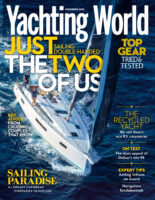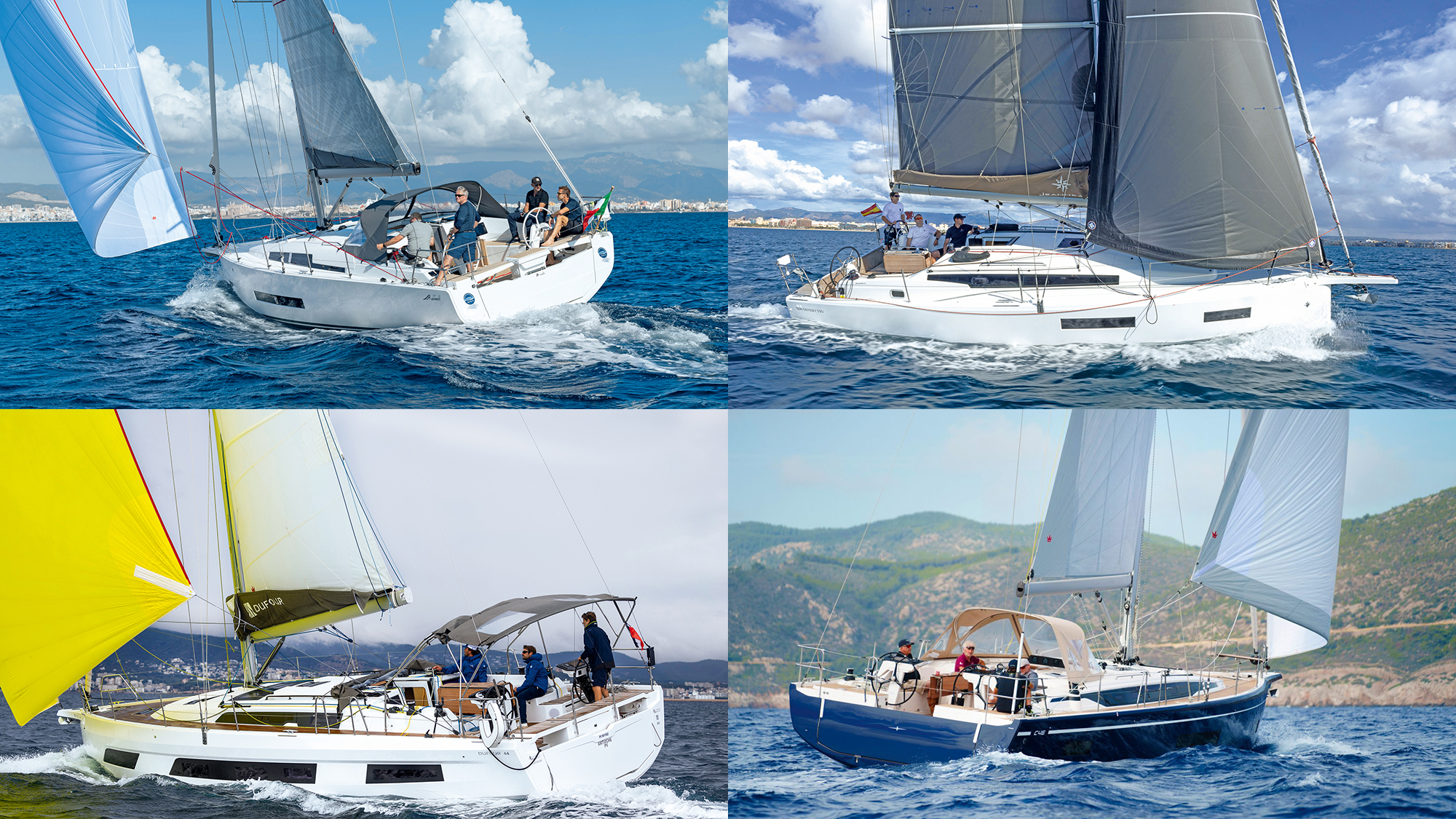This premium quality semi-custom Saare 47 gives Theo Stocker a pleasant surprise during a two-day sail in Germany
Saare 47 review: A proper, take you anywhere cruiser
The afternoon sunlight had that sharp clarity of spring in the Baltic; warm and golden, but with cold shadows in which the world felt suspended, undecided at winter’s retreat. Silently, we drifted in the Saare 47 out past the church spire, the lighthouse on the harbour mole, and the deserted basket-chairs on the white sand beach.
The mirror flat water began to ruffle into the softest of carpets across which to glide, as the breeze tumbled over the town before steadying itself further out. With the wind gusting from 5 to 17 knots, and shifting several compass points at a time, our wake was that of a drunkard, though my eyes were glued to the telltales.
I was in Eckernförde, where Germany teeters on the edge of Scandinavia, to sail this new Saare 47, the luxury flagship of the small-volume boatbuilder. If you’ve not heard of Saare Yachts, that’s because they only build half a dozen or so boats a year. The brand, though relatively young, grew out of a yard where 250 Finngulfs were built on the Estonian island of Saaremaa, where a centuries-old boatbuilding heritage pre-dates the Soviet era isolation.
Many other well-known yacht marques have their hulls moulded on the same island, close to the University of Tallinn’s faculty of naval architecture. In 2016, the yard was bought by Saare’s German dealers, who now work hand in hand with their Estonian colleagues, with the aim of creating a small but steady stream of beautiful boats, built well, by a long-term sustainable business to designs that evolve slowly without chasing fashions.
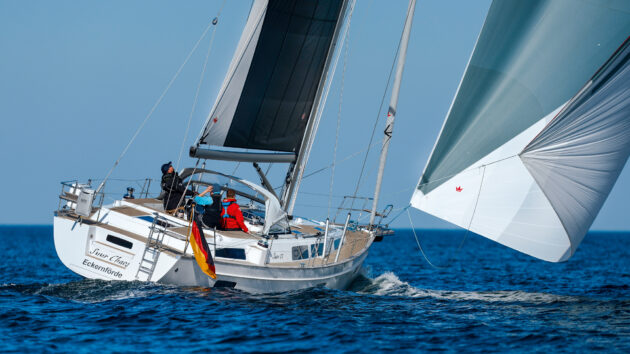
The Saare feels solid, planted in the water, and able to respond to the wind in a way that most performance cruisers would aspire to, let alone a bluewater boat. Photo: Paul Wyeth
Today’s Saare 47 is a serious, long-distance bluewater cruising yacht, capable of taking on the world’s oceans. Light, flukey airs might not be the conditions you’d want to test a boat’s heavy weather capability for mid-ocean storms, but they can tell you a lot about a hull.
Despite her stunning joinery, a full owner’s suite in the stern, and even a washing machine, this boat is comparatively light at 13-tonnes – a good two tonnes lighter than some of her immediate competitors. Her relatively slender and well-balanced lines, reminiscent of her smaller sisters, hide modern construction, helping create a slippery and easily driven hull.
Below the water she is relatively deep and evenly rounded with minimal wetted surface area and a shape that makes for a capable sea boat. Augmented by a ballast ratio of 40% with five tonnes of lead at the bottom of a 2.2m keel, she promises to be stiff and weatherly.
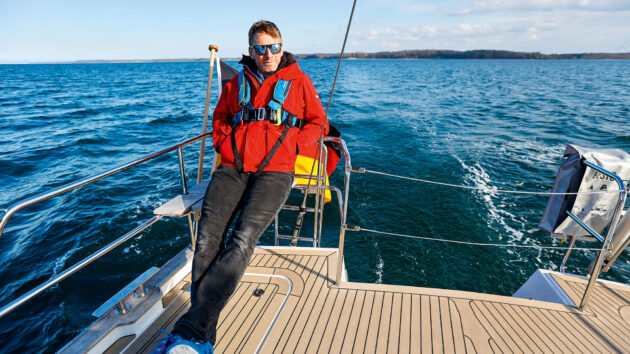
Theo enjoys the view from the ‘gin-and-tonic’ seats. Photo: Paul Wyeth
Smooth sailing
After we set the asymmetric to clear the shoreline, the Saare 47 responded eagerly in the faintest puffs, and notably kept her way on through the lulls. As the true wind reached a heady 5 knots, boat speed matched the breeze, creeping up to 6 knots upwind thanks to apparent wind. Later, in 10-12 knots true, 7 knots upwind was easily achievable with 15 knots across the deck at 32° apparent wind angle. Off the wind, we sat a consistent 7.5 knots, nudging occasionally over 8 knots, while the boat gave the impression she had plenty more to give.
This then is an easily driven hull, and a stiff boat that won’t gripe. The only wobble I managed to induce, unfairly, was with the 200m2 kite up, designed for 130° wind angle, when a 17-knot gust caught us on a beam reach. The boat rounded up just enough to make the spinnaker flog before regaining grip and calmly bearing away back under the sail.
Article continues below…
XC47 review: is this the best bluewater cruiser ever?
We’re close-hauled in 7-10 knots of true wind, making 6-6.5 knots of boat speed, with the helm beautifully balanced and…
Best family yacht: The best yachts for sailing with the family
There are many categories in the European Yacht of the Year awards, from the best luxury yachts to performance yachts. But some of…
In control
On the helm, she is a beautifully balanced boat, and remains so when heeled, with just the right amount of balance in the rudder to provide both effortless control and rewarding feedback.
The Saare 47 we were sailing had a single-point mainsheet aft of the helm on a 2:1 purchase taken to a Harken winch; the 48V electrical system throughout this boat ensures the winches have plenty of torque and spin up quickly and, thanks to the minimal voltage drop of the system, also means longer cable runs and thinner cables can be used. A traveller aft of the helm is an option I would go for, to allow for centring the boom upwind, though with decent pointing angles anyway, you could argue this boat doesn’t need one.
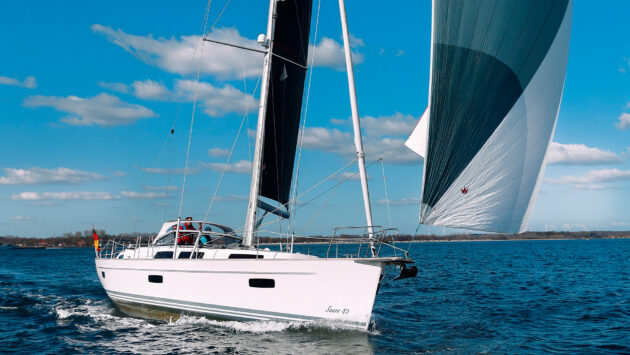
In light airs, the boat was eager to get up to speed. Photo: Paul Wyeth
While a slab reefed main is standard, most Saare owners opt for in-mast furling for ease, speed and neatness, and the EPEX laminate fully battened main from Elvstrom gave a very good shape and control. This was coupled with a 105% overlapping genoa – there would be space for another 10-15% overlap outside the inner shrouds if you regularly sail in light airs, though for most purposes the Code 0 we had on board would be more than sufficient for most points of sail.
The jib is set on a below-deck manual furler, with the line taken aft to the electric halyard winch, a setup the builders find more robust and useful than an electric furler. Sheets are led aft to primary winches on plinths outboard of the wide coamings, via towable cars on long tracks. The distance of the winches outboard keeps them away from inadvertent handling, but means it’s a bit of a stretch for easing leeward sheets when heeled, or for manually winching.
A wide bowsprit offers inboard and outboard attachments for offwind sails, as well as a convenient ladder and stepping off point for bows-first boarding.
You’ll want plenty of anchor chain for proper cruising; 60m of 10mm stainless steel chain barely touched the sides of the large locker. This is also home to the secondary shore power connection point, which means you don’t have trail a cable all over your lovely decks if the pontoon power is forward of the boat. The other cable is under a hinged step in the transom. Here you reach the electric slide-out bathing platform, which is fully watertight and driven on Harken linear drives.
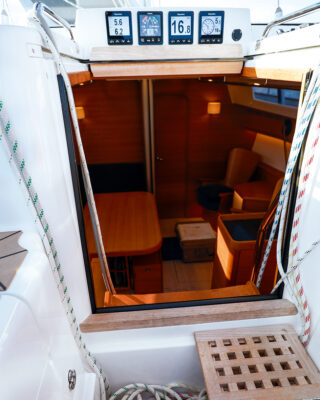
Deep well below the grating takes rope and stops water going down the comfortably low threshold. Photo: Paul Wyeth
The only nit-picking complaints are that the winch plinths, which double as steps for the high cockpit coamings, are too far aft to use while holding onto the sprayhood. I would want steps further forward – and on a semi-custom boat like this, that isn’t a problem as they can be added at the moulding stage.
I would also welcome some stowage for cups, bottles and binoculars on the forward side of the wheel binnacle.
The cockpit itself is deep and exceptionally well protected thanks to the large, single-piece windscreen and sprayhood. You can opt for a hard-top doghouse or targa arch, under which the halyard winches shelter, with lines led to a rope bin. The companionway threshhold has been kept low to minimise the barriers between on deck and below, with water diverted by the recess below the cockpit sole grating, which doubles as a rope bin.
On deck, the boat’s appearance is elegant. Freeboard has been kept low, and the coachroof taken slightly higher, achieving both a deep, well protected cockpit and pleasant lines, while down below the coachroof windows are at eye level when standing, giving the impression of being aboard a deck saloon.
Our boat was fitted with a 75hp saildrive and three-bladed folding Flexofold prop. A 110hp saildrive is an option, as is a shaft drive.
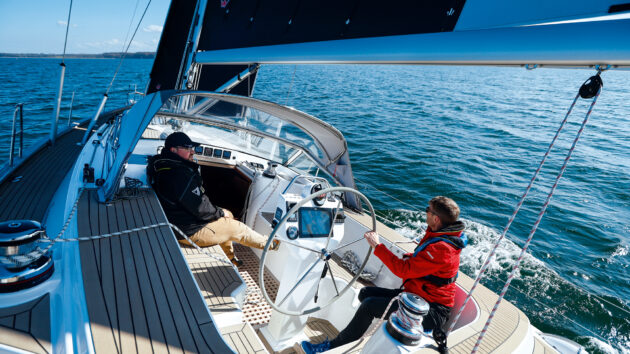
esponsive helm from rod-linked steering and a single wheel. A larger wheel is an option if you like sitting atop the coamings. Photo: Paul Wyeth
It’s worth noting this is fitted with two alternators: the standard 12V 115A Volvo alternator and an additional Bamar 48V alternator that can chuck out 3.6kW at max load. This saps a little bit of speed underway, but means you can run the engine in neutral and put load on it for more efficient charging as you would a generator. Even so, cruising at 2,300rpm gives 7 knots, and a top speed of 8 knots at 2,700rpm.
The Saare 47 is also a responsive boat to manoeuvre. With the propeller close to the single rudder, it turns inside one and a half boat lengths, aided at close quarters by optional retractable bow- and stern-thrusters. These brushless Sleipner motors allow for proportional thrust and the function to hold you alongside while you sort your lines out if sailing the boat single-handed.
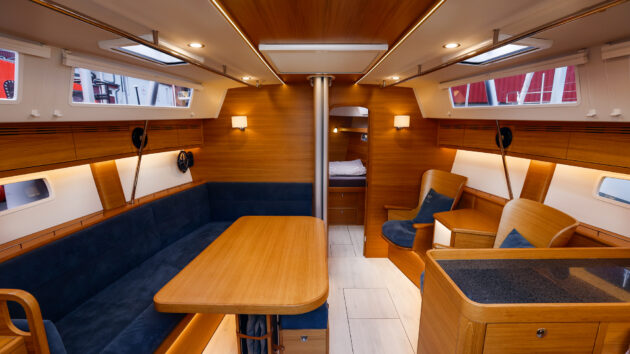
Despite the feeling of space, there are no vast tracts of open space to fall across when heeled, and handholds abound. Photo: Paul Wyeth
Sleeping easy
It isn’t always easy reviewing a boat which can be adapted to an owner’s wishes as much as Saare yachts can. I’m not asking for your pity – I did, after all, have two sunny days on a £1m-plus yacht in the Baltic. But if something isn’t to your fancy, it can be changed to how you like it. This is no set-in-stone production boat.
To that end, the accommodation in particular has a set of standard options for layout, but then it can be refined to tastes. As a centre cockpit boat, there’s no negotiating a large owner’s cabin aft and a large forward cabin, both with ensuite heads and shower compartments. In the saloon then, you have a table and L-shaped seating, with extra stools and a folding chair around it forward to port.
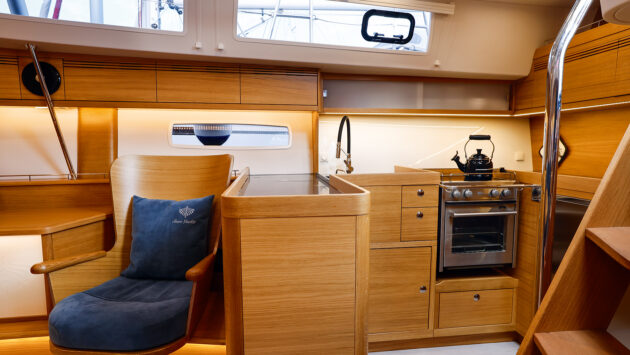
Induction hob and electric oven are at the galley’s heart. Photo: Paul Wyeth
However, everything else is open to discussion, including a straight settee or double armchairs to starboard, while the galley can be down to port and aft into the walk through, or as on our boat, as a C-shaped unit to starboard. If you want a pantry wall, with additional cupboards, dishwasher, microwave etc, that can all be built in, or you could give some space over to a utility/technical room, stealing some aft heads area.
If you put the galley to port, the generous forward-facing chart table can move elsewhere and the space to starboard can become a third cabin with bunk beds, or an office space complete with desk and book shelves, either enclosed or open. Our boat also had a fold-out flatscreen TV, serving both the chart table for work and navigation, and the saloon for entertainment.
There is an embarrassment of choice when it comes to finishing details. The test boat had waterproof and unscratchable wood-effect vinyl flooring, though varnished real wood, or even carpet, is an option. Upholstery choices are unlimited, though 18 colours and fabrics are standard offerings. Joinerwork is limited to either light European oak or Khaya mahogany.

You can have a large forward facing chart table to port, as here, or the galley could go here instead. Photo: Paul Wyeth
Stowage is plentiful. In our layout at least this entails full-length overhead lockers, a drinks cabinet between the armchairs, and an array of lockers in the passageway to the aft cabin, and below all of the bunks and settees. The galley itself has a top-opening fridge, a front-opening fridge, and a top-opening freezer. Outboard is a single sink (I’d opt for a 1.5 sink for drying washed items), and a two-hob GN Espace induction oven.
The fact that this boat is nearly a metre narrower than her competitors has no noticeable impact on the feeling of space down below, thanks to some clever construction and design. The hull-linings, for example, have been kept as thin as possible so as not to waste space, which is noticeable in details like the wooden panelling hiding the chainplates.
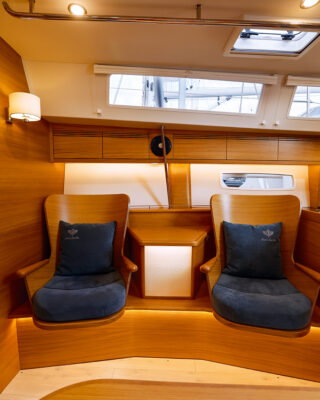
On the test boat the laminated wooden armchairs had carbon fibre layers in the sculpted laminate. Photo: Paul Wyeth
The bow sections on this boat are by modern standards fine and narrow, so in the forward cabin the bunk takes the full width rather than being an island bed. However, the generous sail locker at the bow pushes it aft sufficiently to give you a wide headboard, while the aft end is a massive 230cm wide. Meanwhile, 204cm of headroom creates a real sense of space. The deep mattresses from Fleximar don’t come cheap, but I’ve rarely slept so comfortably. Reading lights at both ends of the bed let you decide which way round you want to sleep.
The aft cabin is the real selling point of the yacht. A fully rectangular king-sized berth lies amidships with a similarly luxurious mattress. Stowage is plentiful with multiple upright lockers, plus drawers, cubby holes, a changing seat, vanity table, and even space for a safe. A large heads with separate shower is to starboard, where the washing machine sits in its own locker.
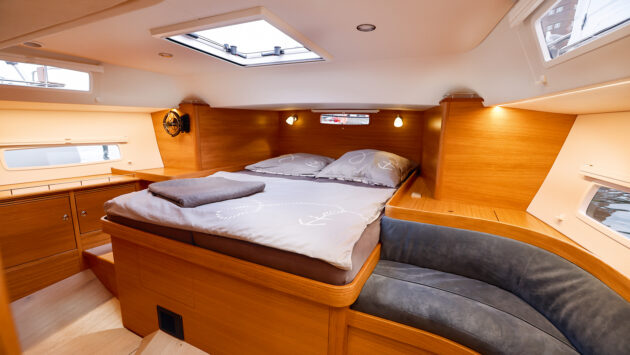
There’s space for a sofa, ample stowage and a large heads round the corner on starboard side. A little more headroom after the aft end of the berth would have been nice. Photo: Paul Wyeth
My only criticism is that because the berth is high enough to accommodate the bathing platform and stern thruster, there isn’t full sitting headroom at the aft, head end of the berth, from where I’d want to enjoy the view in the mornings.
The science bit
The real heart of a true bluewater boat is the technical setup. Access to the Saare 47’s engine space is via double-opening doors in the aft cabin, with all filters easily accessible. That said, the cooling water strainer was at the forward end, so you couldn’t check if it is clear without removing the basket.
Electrical systems are handled in a separate locker under the companionway, forward of the engine compartment. In here are all the chargers, inverters and management systems required to handle the 12V, 24V and 48V systems running on this boat (all from Victron), thanks to that 48V Bamar alternator and the 14.5kWh lithium battery bank this serves. These enable powerful winches, thrusters and windlasses, without the need for additional battery banks or a separate generator.
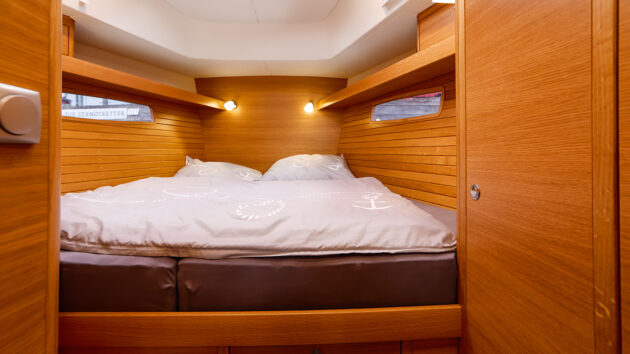
Few forward berths are this large or this comfortable. Photo: Paul Wyeth
The real boon of all this electric power is the ability to to switch to induction cooking and do away with gas entirely, ending the hastle of changing bottles and regulators aboard, not to mention the safety risks associated with gas and carbon monoxide.
Cooking a meal takes just over 1kWh, so you can cook for a week without needing to charge up, and your kettle will boil in no time, with the added benefit that you can run 240V systems whenever you need.
Throughout the boat, much thought has been given to accessing services, and making it easy to service everything without deconstructing the boat.
Where choices have been made about fixtures and fittings, the better quality one has always been chosen.

The forward heads is generously sized. Photo: Paul Wyeth
The fridges for example, are seawater cooled, using seacock heat exchanger skin fittings, thus minimising the number of holes in the hull.
Finally, construction is done properly. The Finnish cast lead keel is bolted into the deep keel stub, which ensures precise keel alignment and a deep bilge sump. A metre either side of the keel and around the rudder the hull is solid laminate, and above that is Divinycell foam core.
Everything on board is vacuum-infused using Vinylester resin, saving over half a tonne compared to hand lay-up. The keel matrix is fully laminated into the hull and extends throughout the hull – Saare didn’t want a steel frame, which had the potential to corrode. All bulkheads are structural and laminated in. Non-structural joinery is honeycomb cored with solid wood veneers to keep weight down.
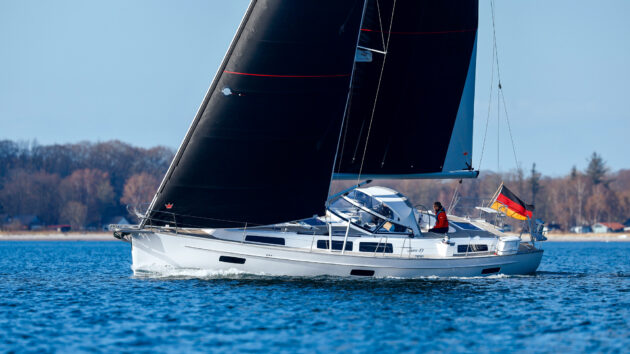
On the helm she is a beautifully balanced boat. Photo: Paul Wyeth
Saare 47 specifications
LOA: 14.28m / 46ft 10in
LWL: 12.55m / 41ft 2in
Beam: 4.20m / 13ft 9in
Draught: 2.20m / 7ft 3in (2.00m / 6ft 7in)
Displacement: 13,000kg / 28,660lb
Ballast (lead): 5,050kg / 11,133lb
Sail area: 110m2 / 1,184ft2
SA/disp ratio: 20.2
Bal/disp ratio: 39%
Disp/length ratio: 183.5
Engine: 75hp
Water: 503lt / 111gal (+ optional 300lt / 66gal)
Fuel: 392lt / 86gal (+ optional 300lt / 66gal)
Designer: Karl-Johan Stråhlmann
Price as tested: £1m – £1.1m inc VAT
Builder: Saare Yachts
 If you enjoyed this….
If you enjoyed this….
Yachting World is the world’s leading magazine for bluewater cruisers and offshore sailors. Every month we have inspirational adventures and practical features to help you realise your sailing dreams.Build your knowledge with a subscription delivered to your door. See our latest offers and save at least 30% off the cover price.
Note: We may earn a commission when you buy through links on our site, at no extra cost to you. This doesn’t affect our editorial independence.
Verdict
The Saare sets out to be a true, take-you-anywhere cruising yacht, for coastal, offshore or bluewater, to be easily handled by a short-handed crew, and lived aboard in more than a little comfort for extended periods. She is intended to sail right across the wind range, from zephyrs to gales. As the owners say: ‘We set out to build boats the right way, and it will cost what it costs.’ That’s not how you build a cheap boat, but it is how you build a good boat. While the hull is obviously predetermined and there are roughly standard layout options, by hand building in small numbers, almost everything else can be changed, for a price. The 47 is highly customisable, so if this is the kind of boat you’re looking for, then you can work with the builders to make it fit you perfectly. The good news is that she does sail well – beautifully, in fact. She isn’t a sportsboat nor one you’ll be able to get up on the plane. For most bluewater cruisers, that’s good news too. What you do get is a light, fast and efficient hull that is responsive, perfectly well-mannered and consistently quick that will eat up the miles on passage. The fact that she is so easily driven in light airs is a good sign, and the narrow, deep hull, massive ballast and balanced shape should make her good in a blow. While not cheap, the Saare isn’t out of line with her competitors, most of which offer far fewer options to mould them into the yacht of your dreams.

